Guests learn about bacteriophage therapy during August NMHM Medical Museum Science Café
By: Paul Bello, National Museum of Health and Medicine
SILVER SPRING, Md. – A discussion about the world of bacteriophage therapy and its place in modern-day science took place Aug. 26 at the Silver Spring Civic Building. The National Museum of Health and Medicine (NMHM) continued its monthly Medical Museum Science Café series by welcoming speakers Dr. Mikeljon P. Nikolich, chief of the Emerging Bacterial Infections Department in the Bacterial Diseases Branch at the Walter Reed Army Institute of Research (WRAIR) and Professor Crystal Scott, an embryologist who teaches microbiology at James Madison University (JMU).
The discussion, entitled "Bacteriophage Therapy: Is There an Alternative to Antibiotics?" began with an introduction from Nikolich, who also serves as WRAIR’s science director for its new overseas lab in the nation of Georgia. He has studied bacteriophage therapy since 2008. While an initial observation into bacteriophage was made back in 1896, he said it would be nearly 20 years later before they were actually first reported as viruses of bacteria. Felix d’Herelle, a French Canadian microbiologist, would later coin the term "bacteriophage" and initiate the first attempts to use them for antibacterial therapy.
According to Nikolich, a bacteriophage (or phage) is a virus that infects a specific bacterial host and consequently destroys the infected cell. Use of phages, he said, is particularly beneficial in helping with bacterial diagnosis, detection applications, and decontamination of food products. He said there has been a recent surge among science professionals in applying bacteriophage as an alternative to anti-bacterials, due to the reduction of antibiotic options presently available to the public because of drug resistance.
While phages are actively used as therapeutics in former Soviet Union countries and Eastern Europe, Nikolich said they have been approved thus far by the U.S. Food and Drug Administration (FDA) solely for decontamination of food products.
"Therapy remains controversial in the West due to clinical trials not being done to the standards and ethics we currently have in place. Though, we have seen that gradually changing," Nikolich said. "Multi-drug resistance is a huge factor that’s driving the research. Throughout the world, people are interested in finding alternative options to antibiotics."
Currently, Nikolich said the main challenge with bacteriophage therapy is that a single phage cannot usually be used to treat a disease because of its high specificity for only some bacteria within a species. For some diseases phage mixes would therefore need to be tailored to a specific geographic region. Despite these obstacles, however, he noted several advantages. Among them, a bacteriophage is very specific to a particular bacteria and can be replicated and adapt quite easily. They also generally do not contain genes that are detrimental to humans.
Because multi-drug infections are a problem in the military, just like in civilian life, Nikolich said the U.S. Army has been proactive in studying bacteriophages the last several years. He said research has been conducted on biodefense, drug resistant wound infections and diarrheal diseases. The military is also involved in a collaboration petitioning the FDA to introduce a phage therapeutic product as an investigational new drug (IND), Nikolich said.
Scott followed with a presentation on how she hopes to inspire students in the field of microbiology. She believes bacteriophages can be instrumental in treating cases of staph infections, dysentery, bubonic plague, burns or other open wounds.
"I tell students to be outstanding in a field of outstanding people," Scott said. "I’m completely fascinated by the world we can’t see so easily. That’s what has driven me as a scientist."
Scott, who was joined at the discussion along with four of her students from JMU, said there are more bacteriophages in the world than there are stars in the Milky Way galaxy, or grains of sand on a beach. At JMU, she said students are involved in scientific research to isolate and identify phages. They work to isolate phages that can infect either mycobacterium (the most common form causing tuberculosis), or bacillus (which can cause infections such as anthrax). She said students also work to isolate viruses that infect the bacteria of interest. This is followed by a series of steps to purify their phages, image it with transmission electron microscopy, extract DNA and finally annotate the viral genome.
"One of the goals we set for our undergraduates is to publish and have their work recognized by their peers, teachers, and other professionals. I don’t think there’s anything that speaks louder than that," Scott said. "We allow our students to present at national conferences and network with industry leading scientists. They are hooked by the idea of finding an answer to the treatment of a bacterial infection in a way that doesn't involve an arms race against antibiotics."
Her students recently visited the Janelia Farm Research Campus of the Howard Hughes Medical Institute in Ashburn, Va., for a presentation on bacteriophage therapy and science. They have also taken part in the Science Education Alliance program which trains students to think like a scientist.
NMHM's Medical Museum Science Cafés are a regular series of informal talks that connect the mission of the Department of Defense museum with the public. NMHM was founded as the Army Medical Museum in 1862 and moved to its new location in Silver Spring, Md. in 2012. The next Science Café is entitled "The Smart Neuro ICU: Treating Brain Injuries in the Information Age," and will be held Sept. 23, at 6 p.m, in the Silver spring Civic Building.
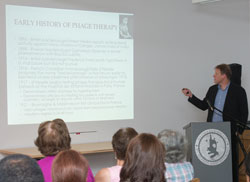 |
Caption: Dr. Mikeljon P. Nikolich, chief of the Emerging Bacterial Infections Department and Bacterial Diseases Branch at the Walter Reed Army Institute of Research (WRAIR), provides an early history of bacteriophage therapy during his presentation at the Medical Museum Science Café Aug. 26 at the Silver Spring Civic Building. The discussion is part of a monthly series of science and health related topics hosted by the National Museum of Health and Medicine. |
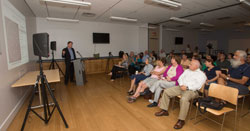 |
Caption: Dr. Mikeljon P. Nikolich, chief of the Emerging Bacterial Infections Department and Bacterial Diseases Branch at the Walter Reed Army Institute of Research (WRAIR), speaks to guests at the National Museum of Health and Medicine’s monthly Medical Museum Science Café, which was held Aug. 26 at the Silver Spring Civic Building. |
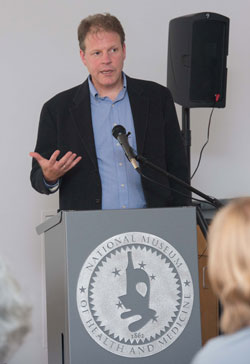 |
Caption: Dr. Mikeljon P. Nikolich, chief of the Emerging Bacterial Infections Department and Bacterial Diseases Branch at the Walter Reed Army Institute of Research (WRAIR), answers a question during his presentation on bacteriophage therapy Aug. 26 at the Silver Spring Civic Building. The discussion is part of the monthly Medical Museum Science Café series of science and health related topics hosted by the National Museum of Health and Medicine. |
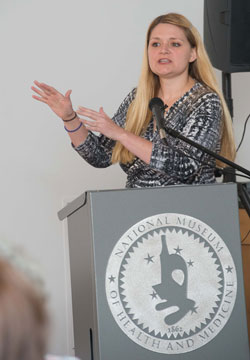 |
Caption: Professor Crystal Scott, an embryologist who teaches microbiology at James Madison University (JMU), elaborates on the research involved with bacteriophage therapy during her presentation Aug. 26 at the Medical Museum Science Café held at the Silver Spring Civic Building. The discussion is part of a monthly series of science and health related topics hosted by the National Museum of Health and Medicine. |
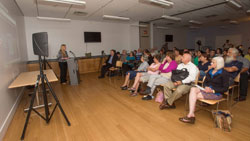 |
Caption: Professor Crystal Scott, an embryologist who teaches microbiology at James Madison University (JMU), addresses audience members during her presentation at the Medical Museum Science Café, which was held at the Silver Spring Civic Building Aug. 26. The discussion is part of a monthly series of science and health related topics hosted by the National Museum of Health and Medicine. |



